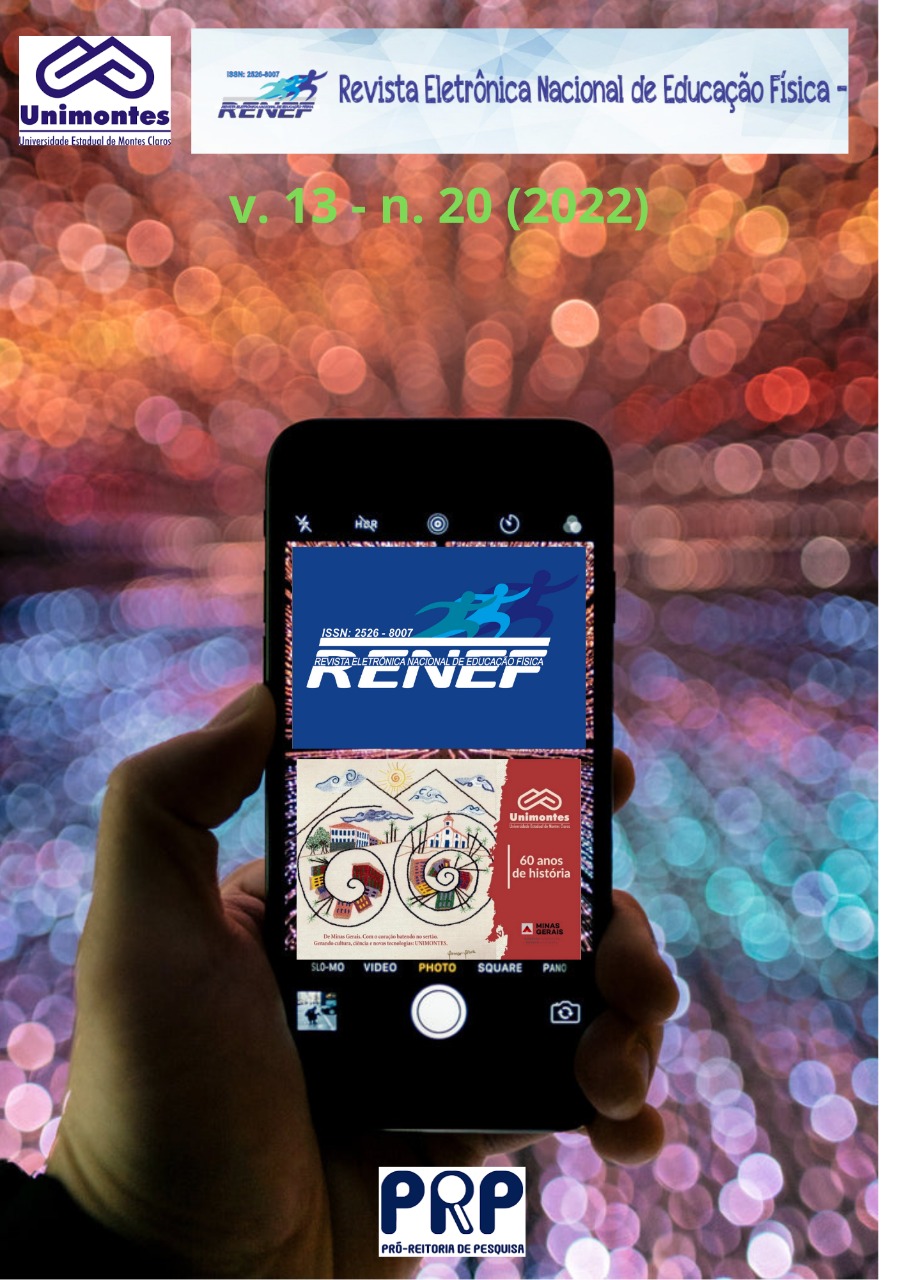EFEITO DO EXERCÍCIO FÍSICO NO VOLUME TUMORAL DE CAMUNDONGOS C57BL/6 COM MELANOMA CUTÂNEO
DOI:
https://doi.org/10.46551/rn2022132000064Palavras-chave:
Atividade Física; Câncer de Pele; Massa tumoral.Resumo
O presente estudo verificou os efeitos do exercício físico resistido no volume tumoral de camundongos C57BL/6 com melanoma cutâneo. Para o experimento foram utilizados 16 (dezesseis) camundongos fêmeas C57BL/6 no total, com idade de vida de 10-12 semanas, com cerca de 20 ± 5 gr de peso corporal. Os grupos foram divididos em 2 grupos: I. grupo controle (n=8) e II. grupo experimental (n=8). As avaliações do volume tumoral ocorreram 7 e 13 dias após a inoculação. O grupo experimental iniciou o exercício resistido 7 dias antes da inoculação, no dia da inoculação não ocorreu a sessão do exercício resistido. O grupo controle era mantido no alojamento de caixas autoclavável de polipropileno descritas anteriormente. O nível de confiança adotado em todas as análises será fixado em 95% (p < 0.05). Foi realizado o teste Shapiro-Wilk para verificação da normalidade. Após tal analise, foi realizado o teste Mann-Whitney. O crescimento do volume tumoral do grupo controle comparado o grupo experimental não teve diferença significativa (p=1,000). Importante salientar que o valor de delta apresentado no grupo controle (Δ = 521,71 +174,29) foi maior que a média do grupo experimental (Δ= 413,45 +440,29). O exercício resistido não promoveu retardo no crescimento tumoral.
Downloads
Referências
BRASIL. Ministério da Saúde. Instituto Nacional do Câncer. O que é câncer. 2020. Disponível em: https://www.inca.gov.br/o-que-e-cancer. Acesso em: 28 ago. 2021.
BEZERRA, Maria Eduarda Lopes de Macedo et al. Fração prevenível da atividade física e câncer. Research, Society and Development, v. 10, n. 8, e50410817565, 2021 (DOI: http://dx.doi.org/10.33448/rsd-v10i8.17565
Centro de Referências de Tumores Cutâneos. Melanoma. 2018. Disponível em: https://www.accamargo.org.br/sites/default/files/2020-08/cartilha_melanoma.pdf. Acesso em: 28 ago. 2021.
COSTA, Giovana Evelin de Oliveira et al. Efeito do treinamento resistido com choque no diâmetro, força e peso muscular de camundongos C57BL/6. RBPFEX-Revista Brasileira de Prescrição e Fisiologia do Exercício, v. 14, n. 92, p. 535-540, 2020.
DIAS, Vinicius Rodrigues et al. Effects of resistance training and physical activity on muscle strength, skeletal muscle tissue, white adipose tissue and survival in C57BL/6 mice with cutaneous cachexia related to melanoma. 2018. 25 p. Tese (Doutorado em Ciências da Saúde) - Universidade Estadual de Montes Claros, Universidade Estadual de Montes Claros, 2018.
HOFMANN, P. Cancer and Exercise: Warburg Hypothesis, Tumour Metabolism and High-Intensity Anaerobic Exercise. Sports (Basel). 2018;6(1):10. Published 2018 Jan 31. doi:10.3390/sports6010010
IRWIN, Melinda L. Guia do ACSM para Exercício e Sobrevivência ao Câncer. São Paulo: Phorte, 2015.
MELO, Ana Georgia Calvacanti de; CORADAZZI, Ana Lucia; DEL GIGLIO, Auro; et al. Consenso Brasileiro de Caquexia/Anorexia em cuidados paliativos. Revista Brasileira de Cuidados Paliativos, São Paulo, v. 3, n. 3, p. 1-42, 2011. Disponível em: https://repositorio.usp.br/item/002270528. Acesso em: 9 out. 2021
OAKVIK, Jennifer; READY, Danielle. Updates in Cancer-Related Symptom Management of Anorexia and Cachexia Syndrome. Seminars in Oncology Nursing, Elsevier. 2022. 1 -5 doi: 10.1016/j.soncn.2022.151254
OLIVEIRA, Tayrine Resende de et al. Efeitos da atividade física na histomorfometria muscular esquelética de modelo tumoral murino de caquexia. Revista Pesquisa em Fisioterapia, v. 10, n. 4, p. 642-647, 2020.
Organização Mundial da Saúde. Câncer. 2020. Disponível em: https://www.paho.org/pt/topicos/cancer. Acesso em: 28 ago. 2021
POLLÁN, M.; CASLA-BARRIO, S.; ALFARO, J. et al. Exercise and cancer: a position statement from the Spanish Society of Medical Oncology. Clin Transl Oncol. 2020;22(10):1710-1729. doi:10.1007/s12094-020-02312-y
Sociedade Brasileira de Dermatologia. Câncer da pele. 2017. Disponível em: https://www.sbd.org.br/dermatologia/pele/doencas-e-problemas/cancer-da-pele/64/. Acesso em: 07 out. 2021.
SOARES, Lawrey Vanessa Rocha et al. Efeito do treinamento resistido na sobrevida de camundongos c57bl/6 com caquexia associada ao melanoma cutâneo. Revista Pesquisa em Fisioterapia, [S. l.], v. 11, n. 2, p. 282–286, 2021. DOI: 10.17267/2238-2704rpf.v11i2.3471. Disponível em: https://www5.bahiana.edu.br/index.php/fisioterapia/article/view/3471. Acesso em: 11 nov. 2022.
TEICHER, BA. Tumor Models in Cancer Research. 2a ed. Boston: Humana Press; 2002. p.571-605.
VIEIRA, Sabas Carlos; NASCIMENTO, Ana Lúcia Araújo. Câncer de pele não melanoma. In: VIEIRA, Sabas Carlos. Oncologia Básica para profissionais de Saúde. Teresina: EDUFPI, 2016. p. 95-97. ISBN 978-85-7463-999-4.
Publicado
Versões
- 2022-12-07 (5)
- 2022-12-01 (4)
- 2022-11-29 (3)
- 2022-11-29 (2)
- 2022-11-29 (1)


















